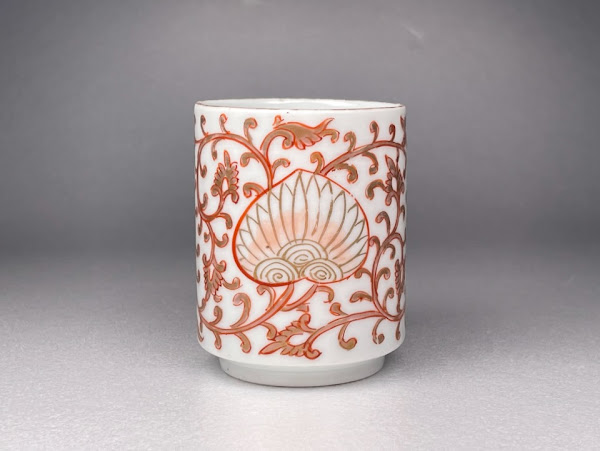金彩唐草ののぞき猪口 Gold Arabesque Pattern Nozoki Cups

金彩の唐草文様の猪口を2つ紹介する。 Two pieces of gold arabesque nozoki -type Imari cup are shown. 1. 金彩 葵唐草文 のぞき猪口 18世紀後半 Late 18th century 口径 top width: 51 mm / 高さ height: 65 mm / 高台径 bottom width: 42 mm 表と裏に葵の葉とおぼしき文様を描き、その周囲を唐草で埋め尽くす。唐草を金彩で描いて、それを赤絵で縁どりするのが特徴的だ。色絵の磁器というのは得てして派手なものが多いが、この器にはむしろ落ち着きや渋さを感じる。 Two hollyhock leaves are drawn on opposite sides and arabesque patterns around them with gold and red glazes. Using these two colors on a white porcelain gives me an impression that it is quiet and tasteful. 2. 染錦 花唐草文 のぞき猪口 18世紀後半 Late 18th century 口径 top width: 51 mm / 高さ height: 61 mm / 高台径 bottom width: 43 mm こちらはまず呉須で「窓」を描き、その上に金彩と赤絵で草花図と唐草文を描いている。唐草の表現方法は前のとおなじ。このあいだの平和島骨董市で入手した。 なんでも金ピカに装飾するのは成金趣味というか、あまりいい印象を抱かないが、これらの猪口の唐草文様についてはわたしはむしろ落ち着きを感じ、とても魅力的におもう。陶芸というのは限られた色で表現せざるを得ないものだが、大げさかもしれないが、この金と赤の表現は色絵磁器におけるある種の極致を示しているようにおもえる。 This Imari cup uses a blue (cobalt) glaze at first to draw window frames and gold and red colors after that to d...

